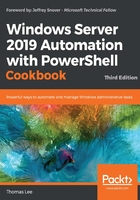
Introduction
At the heart of every organization is the network—the infrastructure that enables client and server systems to interoperate. Windows has included networking features since the early days of Windows for Workgroups 3.1 (and earlier with Microsoft LAN Manager).
Many of the tools that IT pros use today have been around for a long time, but have more recently been replaced by PowerShell cmdlets. In the New ways to do old things recipe, we look at some of the old commands and their replacement cmdlets.
Every server or workstation in your environment needs to have a correct IP configuration. In the Configuring IP addressing recipe, we look at how to set a network interface's IP configuration, including DNS settings.
As an alternative to creating static IP addresses, you can set up a DHCP server to issue IP address configuration to clients by using the Installing and authorizing a DHCP server recipe. Once your DHCP server is set up, you can use the Configuring DHCP scopes recipe to set up the details that your DHCP server is to hand out to clients. In the Configuring IP address from static to DHCP recipe, we set a network interface to get IP configuration from DHCP.
In the Configuring DHCP failover and load balancing recipe, we deploy a second DHCP server and configure it to act as a failover/load balancing DHCP service.
In the final recipe of this chapter, Configuring DNS zones and resource records, we will configure the DNS server on DC1 with zones and additional resource records.